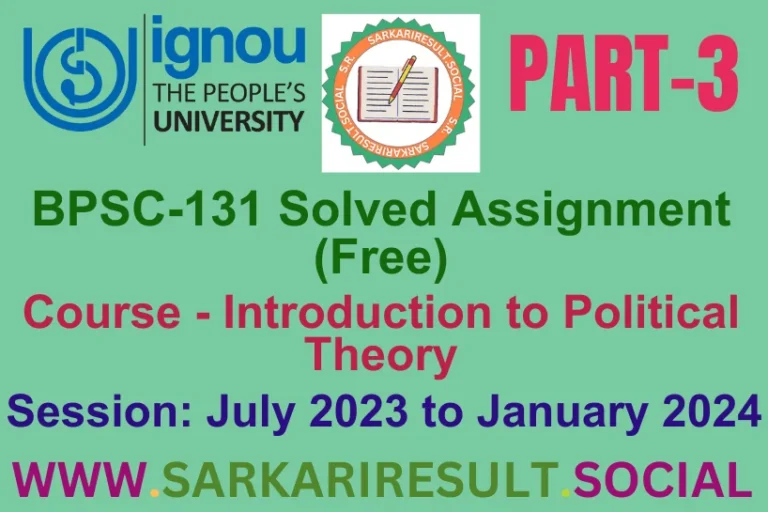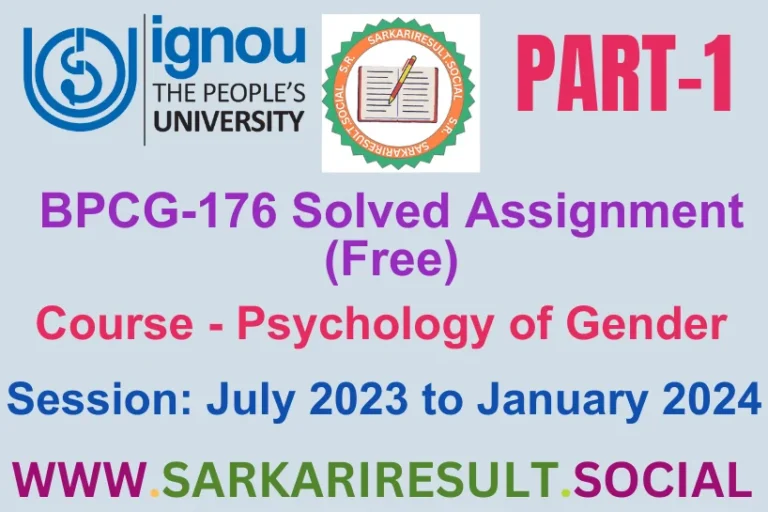Check BSOG 173 IGNOU solved assignment 2023-24 (Free)

BSOG 173 IGNOU solved assignment 2023-24 (Free)
“Boost your performance in BSOG-173 IGNOU solved assignment 2023-24 (Free) Rethinking Development with our expertly crafted solved assignments for 2023-24. The booklet includes three TMAs, with 100 marks and a 30% weightage. Follow the provided guidelines for each category (DCQs, MCQs, SCQs) and submit your answers within the word limit. Submit all assignments before the deadlines to be eligible for the term-end examination. Plan, organize, and present your answers carefully to enhance your writing skills. Get your IGNOU BSOG-173 solved assignment now and excel in the course!”
BSOG 173 Part A Solved (Questions and Answers)
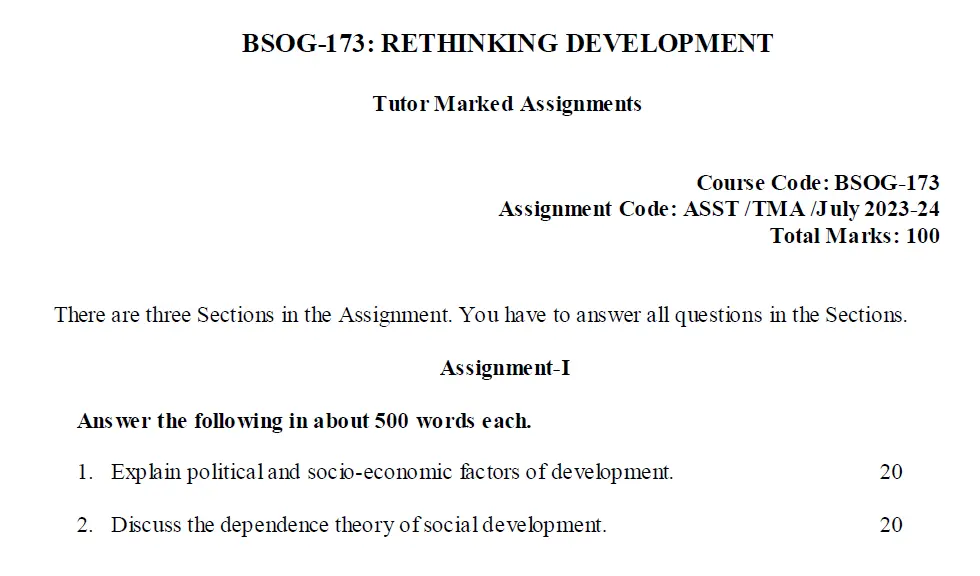
Q.1 Explain political and socio-economic factors of development.
Ans. Development is a complex process that involves a country or society becoming more advanced, improving living standards, and making progress in various aspects of life. This progress is influenced by political and socio-economic factors.
**Political Factors:**
Politics refers to how a country is governed and how decisions are made. Political factors play a significant role in development because they determine how resources are allocated, laws are enforced, and policies are implemented. Here are a few political factors that affect development:
1. **Stability and Peace:** Countries that have stable governments and are at peace tend to develop faster. When people feel safe, they are more likely to invest in their communities and businesses, leading to economic growth.
2. **Good Governance:** Governments that are transparent, accountable, and responsive to the needs of their citizens are more likely to promote development. This includes fair elections, rule of law, and fighting corruption.
3. **Effective Leadership:** Strong and capable leaders can guide a country towards development by making wise decisions and implementing effective policies that benefit the people.
4. **Political Stability:** Frequent changes in leadership or political instability can disrupt development efforts and deter investors, leading to slower progress.
**Socio-Economic Factors:**
Socio-economic factors involve the social and economic conditions of a country or society. These factors greatly influence the pace and nature of development. Here are some key socio-economic factors:
1. **Education:** Access to quality education is crucial for development. Educated individuals can contribute more effectively to the economy, lead healthier lives, and make informed decisions.
2. **Healthcare:** Good healthcare ensures a healthy and productive population. Adequate medical facilities, proper nutrition, and disease prevention contribute to development.
3. **Income and Employment:** A strong economy with sufficient job opportunities and fair wages improves people’s standard of living and reduces poverty.
4. **Infrastructure:** Roads, bridges, electricity, and other infrastructure developments make it easier for businesses to operate and for people to access services.
5. **Social Equality:** Reducing inequalities based on gender, ethnicity, or income is important for development. When everyone has a fair chance, societies can progress more effectively.
6. **Access to Resources:** Availability of resources like clean water, energy, and land for farming is essential for development. Proper management and distribution of resources are important.
7. **Technology:** Technological advancements can accelerate development by improving communication, increasing productivity, and creating new opportunities.
In conclusion, development is influenced by a combination of political and socio-economic factors. Political stability, good governance, education, healthcare, and access to resources all contribute to a society’s progress. It’s important for countries to work on improving these factors to create a better future for their citizens and achieve sustainable development.
Q.2 Discuss the dependence theory of social development.
Ans. The dependence theory is a concept that helps us understand how some countries or regions can become less developed due to their interactions with more powerful and advanced nations. This theory highlights the impact of economic and social relationships on the development of nations, particularly those that are considered less powerful or underdeveloped.
**Key Ideas of Dependence Theory:**
1. **Economic Exploitation:** According to the dependence theory, more powerful nations can exploit less developed countries for their resources and labor. This can hinder the economic growth of the less developed countries, as they may not receive fair compensation for their contributions.
2. **Unequal Trade Relationships:** The theory emphasizes that unequal trade relationships can perpetuate underdevelopment. Less developed countries may be forced to export raw materials at low prices while importing expensive manufactured goods from more developed nations.
3. **Limited Industrialization:** Dependence on external sources for finished goods can prevent less developed countries from building their own industries and manufacturing capabilities. This can hinder their ability to create jobs and increase their economic independence.
4. **Debt Burden:** Less developed countries might borrow money from more developed nations or international institutions. If they are unable to repay these loans, they can become trapped in a cycle of debt that hampers their economic growth and development.
5. **Social Inequality:** Dependence theory also highlights how unequal relationships can lead to social inequalities within a country. The wealthy elite may benefit from the arrangements, while the majority of the population struggles with poverty.
**Implications of Dependence Theory:**
Dependence theory encourages us to recognize the importance of fair and balanced relationships between nations. It raises concerns about exploitation, unequal trade, and the potential negative effects of excessive reliance on external support.
**Addressing Dependence and Promoting Development:**
To address the issues highlighted by the dependence theory, countries can take several steps:
1. **Diversification of Economy:** Less developed countries can work on diversifying their economies, focusing on building domestic industries and reducing their dependence on a single export or sector.
2. **Investment in Education and Innovation:** By investing in education and promoting innovation, countries can enhance their ability to compete on a global scale and create value-added products.
3. **Fair Trade Practices:** Encouraging fair trade practices and negotiating better terms for exports and imports can help level the playing field for less developed countries.
4. **Debt Management:** Managing debt responsibly and seeking sustainable borrowing practices can prevent countries from falling into a cycle of debt.
In conclusion, the dependence theory helps us understand how unequal relationships and economic reliance on more developed nations can impact the development of less powerful countries. It encourages us to work towards fair trade, balanced economic partnerships, and self-sufficiency to promote sustainable and equitable development.
BSOG 173 Part B Solved (Questions and Answers)
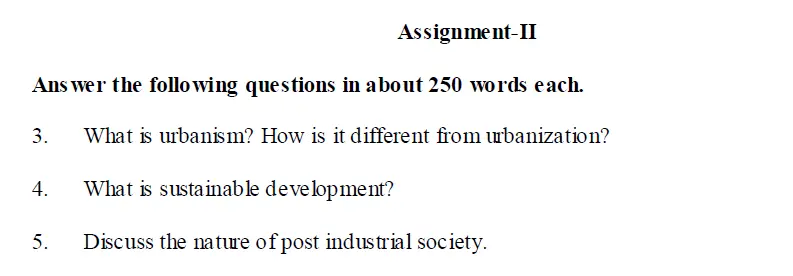
Q.3 What is urbanism? How is it different from urbanization?
Ans. Urbanism refers to the way people live in cities and the characteristics of urban areas. It includes how cities are planned, the types of buildings and infrastructure found in cities, and the lifestyle of city dwellers. Urbanism explores how people interact with each other and their environment in urban settings.
On the other hand, urbanization is the process of more and more people moving from rural (countryside) areas to urban (city) areas. It involves the growth of cities as more people settle in them. Urbanization happens as rural land is transformed into urban spaces with houses, roads, shops, and other structures to accommodate the increasing population.
In simpler terms, urbanism is about the way cities are designed and how people live in them, while urbanization is about the actual growth of cities as more people move from the countryside to live in urban areas. Urbanism focuses on the characteristics and lifestyle of cities, while urbanization focuses on the movement of people and the physical expansion of urban areas.
Q.4 What is sustainable development?
Ans. Sustainable development is a way of improving our lives and the world around us without harming the planet or using up resources that future generations will need. It means finding a balance between what we need now and what the Earth can provide in the long run.
When we talk about sustainable development, we’re talking about making choices that help us live well today while also making sure we don’t damage the environment for tomorrow. This involves using resources like water, air, and land carefully so that they don’t run out or get too polluted.
Sustainable development has three main parts:
1. **Economic Growth:** This means making sure we have enough jobs, businesses, and money to live comfortably. But it’s important to do this in a way that doesn’t use up too much energy or create too much waste.
2. **Social Well-being:** This is about making sure everyone has a chance to be healthy, educated, and safe. It’s important to treat people fairly and make sure they have the things they need to live a good life.
3. **Environmental Protection:** This is all about taking care of the planet. We need to use renewable resources like sunlight and wind power instead of burning too much fossil fuel, which can harm the environment.
Sustainable development is like taking care of a garden – you need to water the plants just enough, give them sunlight, and make sure the soil stays healthy. If we use too much water or don’t take care of the soil, the garden won’t thrive. Similarly, if we use up all the Earth’s resources or pollute too much, it won’t be a good place for us or the generations that come after us.
Q.5 Discuss the nature of post industrial society.
Ans. A post-industrial society is a type of society that has shifted away from relying mainly on factories and manufacturing as its main sources of economic activity. In a post-industrial society, technology, services, and information become more important for creating wealth and providing jobs.
In the past, during the industrial revolution, factories and manufacturing were the heart of society. People worked in factories and produced goods like clothes, machines, and tools. But as technology advanced, machines became more efficient, and fewer workers were needed in factories.
In a post-industrial society, technology and computers play a big role. People now work in offices, providing services like designing websites, managing businesses, and offering expert advice. The focus is on creating and using information. Think about how we rely on smartphones, apps, and the internet for many aspects of our daily lives – that’s a big part of the post-industrial society.
Education is also really important in a post-industrial society. Since jobs are more about using your brain and skills, people need to learn and adapt throughout their lives. This means that learning new things and being creative are highly valued.
In a post-industrial society, cities become even more important. That’s where most of the jobs are, and people live close to where they work. Communities become diverse, with people from different backgrounds and cultures coming together.
In summary, a post-industrial society is all about technology, services, and information. Factories and manufacturing are not as central as before, and people use their skills, creativity, and education to work in offices and create new ideas. This kind of society is focused on using technology, learning, and living in vibrant and diverse cities.
BSOG 173 Part C Solved (Questions and Answers)
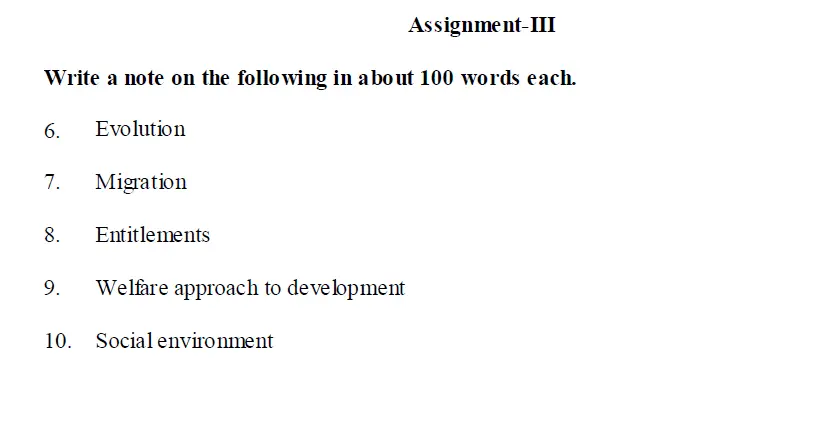
Q.6 Evolution
Ans. Evolution is the gradual process through which living things, like animals and plants, change over long periods of time. It happens because of small changes in their traits, like how they look and behave, which can help them survive better in their environments. Over many generations, these changes add up, leading to new species. Charles Darwin, a scientist, introduced the idea of evolution, showing how animals and plants adapt to their surroundings. It’s like a slow, ongoing transformation that shapes the diversity of life on Earth.
Q.7 Migration
Ans. Migration is when animals or people move from one place to another. They do this to find better food, escape harsh weather, or find a safer home. Animals like birds and butterflies migrate long distances during different seasons. People can migrate within their country or to another country for jobs, education, or a better life. Migration helps living things find suitable conditions and opportunities for growth and survival.
Q.8 Entitlements
Ans. Entitlements are like special rights or benefits that certain individuals or groups have because of certain reasons. These reasons can include things like age, income, or circumstances. For example, some people might get entitlements like food assistance or healthcare because they have low income. Elderly individuals might receive entitlements like social security to support them during retirement. Entitlements are given to help make sure that everyone has access to basic needs and opportunities, especially when they might face challenges.
Q.9 Welfare approach to development
Ans. The welfare approach to development focuses on improving people’s well-being and quality of life. It aims to provide basic necessities like education, healthcare, and housing to all members of society. This approach believes that when everyone has access to these essentials, it helps reduce poverty and inequality. Governments and organizations work together to create programs and policies that support people in need. The welfare approach aims to create a fair and just society where everyone has a chance to thrive and live a good life.
Q.10 Social environment
Ans. The social environment is the people, relationships, and interactions around us. It includes our family, friends, classmates, and the community we live in. How we communicate, behave, and learn is influenced by the social environment. It shapes our values, beliefs, and culture. Positive social environments support our well-being and growth.


